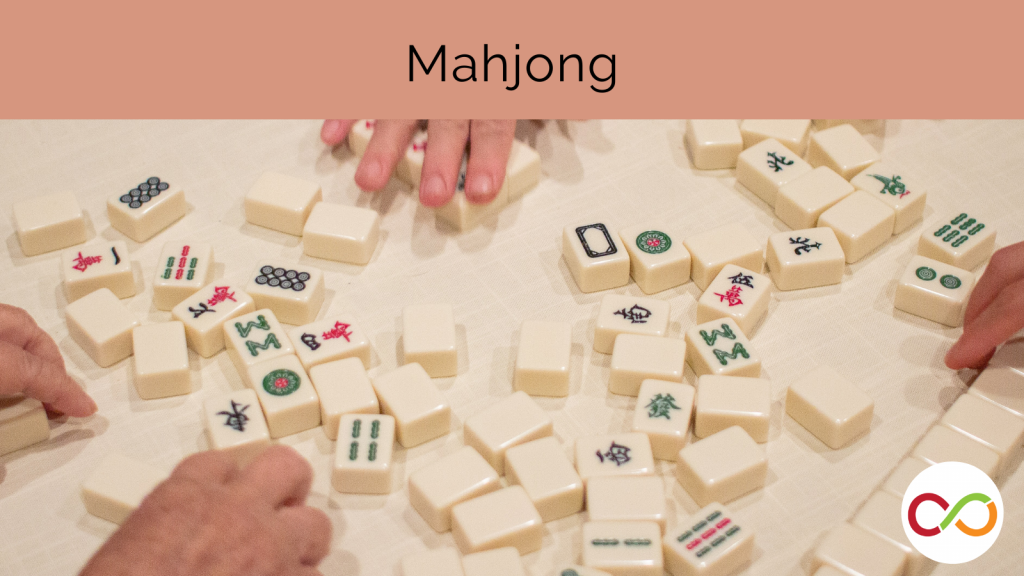Mahjong
Junior (Age 9 – 12)
Curriculum Goal
Junior: Data Management
- Manage, analyze, and use data to make convincing arguments and informed decisions, in various contexts drawn from real life.
- Describe the likelihood that events will happen and use that information to make predictions.
Context
- Students work in small groups of four.
- Students should have previous experience working with probability and understand the likelihood of an event occurring.
- To help students understand how to play Mahjong, this lesson consists of sequential steps. To accommodate students’ developmental level and readiness, the teacher can adjust the pace and pause at any step.
Materials
Lesson
Step One: Get familiar with Mahjong tiles.
- Introduce the Mahjong tiles to the students.
- There are three suits: Dot, Bamboo, and Character.
- In each suit, tiles are numbered from one to nine.
- For each numbered tile, there are four identical copies.
- Ask students to determine the total number of tiles (Ex. 3x9x4=108).
- Provide students additional opportunities to familiarize themselves with the tiles by playing matching games or Go Fish (Optional).
Step Two: Understand how to make a set.
- The primary rule of making a set is to use tiles from the same suit of Dot, Bamboo, or Character.
- Introduce the three types of sets.
- Sequence: three consecutive tiles.
- Triplets: three identical tiles.
- Quads: four identical tiles.
- Practice playing the game called Set with the Mahjong tiles.
- Each player is dealt 13 tiles as their starting hand.
- If a player has any sets in their hand, they expose the tiles and announce the type of set it is.
- Moving counterclockwise, each player draws and discards one tile as they work toward completing a set.
- After each draw, if a set appears, the player will repeat the process of exposing the tiles and announcing the type of set.
- The player who completes four sets first wins the game.
Step Three: Play a challenging version of Set.
- This version of the game incorporates a new rule that allows players to steal tiles.
- One player can steal a newly discarded tile from the player to their left to complete a sequence.
- After stealing a tile to complete a set, the player will expose the set to the group and discard one tile from their hand. If a quad set is completed, the player needs to draw a tile before discarding.
- Students will continue to play as they did in step two while accommodating the new rule. The player that completes four sets first wins the game.
Step Four: Play Mahjong.
- The goal of Mahjong is to be the first player to complete a winning hand. A standard winning hand consists of an identical pair and four sets.
- A player forms a winning hand by using the 13 tiles in their hand and a newly drawn or discarded tile.
- In this version, players only expose the sets that are completed with a stolen tile. Sets that are completed from the starting hand or from drawing tiles can be kept concealed.
- Students will continue to play as they did in step three while accommodating the new rule. The player that forms a winning hand wins the game.
- Have students reflect on how concealing the sets makes the game more challenging.

Look Fors
- What strategies do the students implement to form their hand?
- Do students demonstrate an understanding of the probability of an event occurring?
- Do the students’ choices reflect the likelihood of the events occurrence?
- Do the students understand how to complete a set?
- Do the students demonstrate and understanding there are various possibilities for creating sets?
- Can students describe why they chose to discard certain tiles?
- Do students pay attention to the tiles other players draw and discard, and use that information to help them decide which tiles they should collect to make a set (e.g., If the player ahead of them draws and keeps 6’s, they know not to try and make a set using 6’s because the other player has them all)?
Extension
- Have students pair up to share a hand and make decisions collaboratively.
- Ask students to determine the likelihood of completing their set.
- Ask students to make predictions about which tile they will draw next.
- Ask students questions that require calculations, such as the likelihood of an event’s occurrence. For example, “If you have tiles 6, 6, 7, 7 from the same suit, what is the likelihood of making two triplets, and two sequences?”
Created by Shuai. Adapted by The Robertson Program.
Share this lesson
Share on facebook
Share on twitter
Share on email
